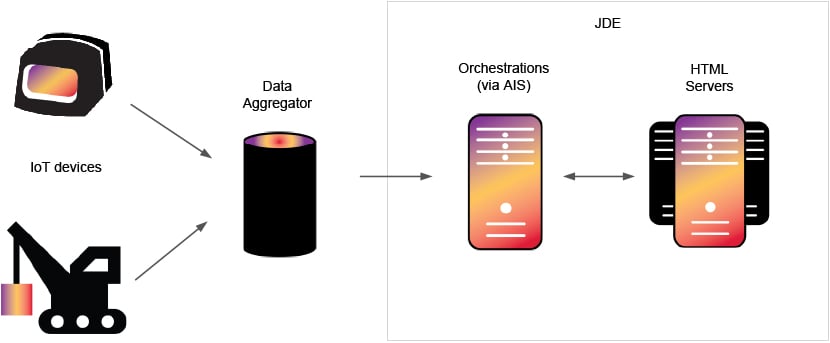5 Tech Integrations Commonly Used with JDE
February 1st, 2024
3 min read
.png?width=960&height=540&name=Blog%20Images%20(20).png)
JD Edwards is an ERP software that many companies rely on to manage their business processes and data. However, no single system can meet all needs, so integrating JD Edwards with other applications is common.
This blog covers the details of common JD Edwards integrations, best practices for implementation, and challenges that can arise.
Common System Integrations
Some of the most frequently integrated systems with JD Edwards include inventory tracking, cross-company systems, payment processing, data warehouses, and third-party software.
IoT
Under the umbrella of IoT are several devices capable of integration with JD Edwards. The interconnected network of physical devices, vehicles, appliances, and other objects embedded with sensors, software, and connectivity allows them to collect and exchange data.

This web of connected devices enables seamless communication and data sharing, leading to increased efficiency, automation, and improved decision-making processes. Devices within the IoT ecosystem can be remotely monitored, controlled, optimized, and integrated with JD Edwards to gain further insights from said data
Inventory tracking
Inventory tracking solutions like barcode scanning, RFID and QR codes are used to track items as they move through warehouses and between locations. This provides visibility into inventory levels and locations in real-time.
Bypassing the need for a third-party scanning integration is ERP Suites Scanability, a JD Edwards barcode scanning solution with an architecture built using Orchestrations. JDE compatibility ensures swift results for the customer, while Orchestrations allows for efficient and cost-effective personalization.
Cross-company systems
Cross-company systems integrations are also common for companies that have grown through acquisitions and need to connect them. Different divisions may utilize different legacy ERP systems. This occurs most often as a result of a divestiture, merger, or acquisition scenario. As such, it is possible to see JDE integration with SAP, Peoplesoft, and EBS. Examples of Enterprise integration platforms are Oracle Integration Cloud, Boomi and IBM MQ/API Connect are a few options to consider.
Data warehouses
Data warehouses running on purpose-driven databases like Oracle Analytics/Business Intelligence, Microsoft PowerBI, Redshift and Snowflake are commonly integrated to provide reporting capabilities, as they are optimized for analytics in a way that JD Edwards may not be. Data warehouse analytic systems on-premises or in the public cloud can provide a bevy of additional data insights and consolidation from Enterprise systems and many other data sources within a company.
Third-party software and cloud integration
Oracle or third-party software integrations fill functional gaps - for example, integrating transportation management software if JD Edwards' transportation module does not meet needs. Oracle transportation management in the cloud is one example. Payment processing is another key integration, as JD Edwards does not natively handle credit card or other payment processing. Many companies use options like Salesforce or Shopify.
Best Practices for Implementing Integrations
Before implementing integrations, it’s important to consider the interface/API type and data size.
REST APIs
REST utilizes an AIS server, and these have become the standard interface for new integrations rather than SOAP, as REST is more widely adopted. SOAP utilizes a Business Services (BSSV) server, which has waned in popularity in recent years.
REST has many attractive qualities for users: it can be inbound or outbound, occurs in real time, and the AIS server REST uses allows for Orchestrations. ERP Suites Mobility is a mobile application that uses the AIS server/REST interface.
Integration Challenges
When integrating systems over the internet, security is paramount. Encryption, whitelisting approved IP addresses, and geofencing to restrict access by location help safeguard data in transit. Infrastructure security like firewalls and endpoint protection on individual devices are also still important. Extra security configurations may be needed for incoming versus outgoing integrations.
Integrations can be implemented and maintained using tools like Orchestrations in JD Edwards. Orchestrations allow automating data transfers and triggering additional actions. Logs and data transfers can be monitored, and exceptions handled by notifying appropriate teams. Periodic evaluations during upgrades are another chance to rationalize existing integrations. Third parties are working to provide pre-built integration templates between common systems.
While monitoring capabilities are improving with each JD Edwards release, no single tool provides full monitoring across technical and business systems today. Companies can piece together different options, including Orchestration monitoring and various third-party monitoring tools. ERP Suites Clarity is one such JDE-integrated application monitoring solution available.
Moving Forward
Future capabilities for analytics and machine learning could gain deeper insights into integrations and processes. Scalability varies by integration type - load balancing works well for stateless web transactions but presents challenges for stateful sessions. One JD Edwards option involves load balancing at the application server level. Overall, integrations with JD Edwards require attention to security, automation, monitoring, and periodic evaluation to ensure continued success.
If you’re interested in learning how to leverage tech integrations to your full JDE advantage, drop us a line. We’d love to help.
Leyla Shokoohe is an award-winning journalist with over a decade of experience, specializing in workplace and journalistic storytelling and marketing. As content manager at ERP Suites, she writes articles that help customers understand every step of their individual ERP journey.
Topics:



.png?width=650&height=325&name=Blog%20Images%202_1%20(4).png)
.png?width=650&height=325&name=Blog%20Images%202_1%20(5).png)
.png?width=650&height=325&name=Blog%20Images%202_1%20(3).png)
.png?width=650&height=325&name=Blog%20Images%202_1%20(2).png)
.png?width=650&height=325&name=Blog%20Images%202_1%20(1).png)
.png?width=960&height=540&name=Blog%20Images%20(96).png)

.png?width=960&height=540&name=Blog%20Images%20(90).png)
.png?width=960&height=540&name=Blog%20Images%20(88).png)
.png?width=960&height=540&name=Blog%20Images%20(87).png)
.png?width=960&height=540&name=Blog%20Images%20(86).png)
.png?width=960&height=540&name=Blog%20Images%20(85).png)
.png?width=960&height=540&name=Blog%20Images%20(83).png)
.png?width=960&height=540&name=Blog%20Images%20(82).png)
.png?width=960&height=540&name=Blog%20Images%20(80).png)